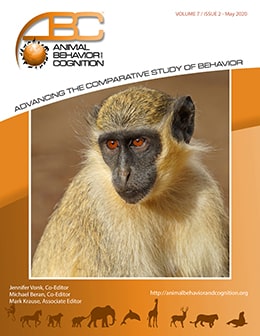Vol 7, Issue 2, May 2020
Primate Pragmatics, Expressive Behavior and the Evolution of Language
Citation
Arnold, K., & Bar-On, D. (2020). Primate pragmatics, expressive behavior, and the evolution of language. Animal Behavior and Cognition, 7(2), 117-130. doi: https://doi.org/10.26451/abc.07.02.06.2020
Abstract
Cheney and Seyfarth’s groundbreaking studies on vervet monkey alarm calls paved the way for a serious investigation of what animal signals might mean and their relevance to the evolution of language. Although the question of what drives call production remains largely unanswered, and parallels with language cannot be discerned in this domain, there appear to be some similarities to language in the way primates, and other animals, derive information from utterances by pragmatically interpreting their significance using available contextual cues. We describe some of the advances that Cheney and Seyfarth’s work spurred and illustrate our current understanding using the alarm calling system of putty-nosed monkeys as an example. We also briefly indicate some of the obstacles to adopting either a purely ‘Carnapian’ or purely ‘Gricean’ pragmatic approach to the evolution of language. We conclude by briefly sketching an intermediate pragmatic framework. This framework takes account of the expressive character of a subset of communicative signals that are biologically designed to openly reveal psychological states, thereby allowing mutually beneficial interactions among, specifically, signalers and receivers that live in social groups.
Keywords
Nonhuman primates, Alarm calls, Referential communication, Pragmatics, Expressive communication, Language evolution
